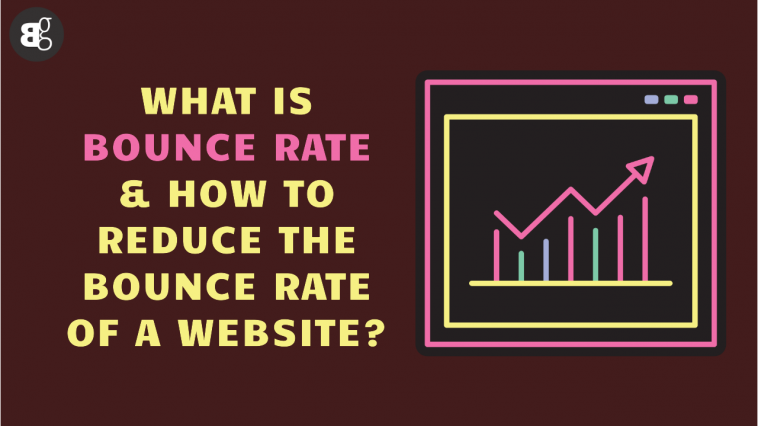Have you ever wondered why people quickly leave your website after visiting? It’s called “bounce rate,” and it’s super important. Bounce rate helps you understand if your website is interesting enough for visitors.
In this article, we’ll explain the bounce rate and share easy ways to lower it. That means more people will stick around on your website and find it excellent. It doesn’t matter if you run a business, make content, or manage a website – learning how to decrease bounce rate can make visitors happier and boost your online success.
Let’s start and make your website awesome together!
What is Bounce Rate?
The percentage of visitors to a website or webpage who arrive and immediately leave without interacting with any other material or undertaking any further activities on the site is referred to as the “bounce rate.” In other words, these visitors simply “bounce” off the page they were initially on.
A high bounce rate implies that either the content on the page must be more fascinating to keep up with visitors’ considerations or that they are not finding what they are searching for.
People use bounce rates to determine whether a webpage is good. When the bounce rate is low, it’s good because visitors are checking out more than just one page.
Why Bounce rate is Important?
There are three key reasons why bounce rate is important:
- Obviously, a visitor who leaves your site without converting. So you can improve your conversion rate by preventing visitors from leaving your website.
- Google Ranking factors may include bounce rate. In fact, a market study discovered a strong relationship between first-page Google results and bounce rate.
- A high bounce rate suggests that your site’s content, user experience, page design, or copywriting need improvement.
Bounce rate in Google Analytics:
Google Analytics is a powerful online tool provided by Google that helps website owners and administrators understand and analyze various aspects of their website’s performance and user interactions. It offers valuable insights into how visitors interact with your website, what content they engage with, how they found it, and much more.
You can use Google Analytics to track key metrics such as the number of visitors, where they are located, the pages they visit, how long visitors stay on your site, and which devices they use.
Additionally, it can reveal the traffic sources, whether from search engines, social media, referral websites, or direct visits. This information assists you with understanding your audience better and tailor your site to their preferences.
The bounce rate in Google Analytics represents the percentage of people who land on a specific webpage and exit without interacting with any other content on your site. Imagine someone arrives at your webpage, takes a quick look, and then leaves without clicking on anything else – that’s a bounce.
This rate is displayed as a percentage and indicates how engaging your webpage is to visitors. A lower bounce rate is generally favorable because it suggests that more visitors are exploring beyond the initial page, meaning they find your website attractive and relevant.
How to reduce the bounce rate of a website?
The following tips will help you lower bounce rates.
1. Improve your content’s readability:
Make sentences shorter. It helps people understand better. Put fewer things in one paragraph. Making content readable keeps readers on track.
Use pictures carefully. Only add them if they help. Bad photos can make people leave. Fast-loading images are good.
Put the “Next Step or Call to Action” at the end. People might miss it in the middle. It’s a button that tells them what to do next.
2. Avoid popups:
Popups can bother people and make them leave your site. They can also create fewer people to share your links. If you don’t want popups, make simple pages without extra stuff. Keep your pages small, and don’t use flashy things. On the off chance that you should utilize a popup, make it straightforward and close.
3. Make a strong call to action (CTA):
The action you want your user to do must be stated clearly. Ensure the CTA is visible if you want them to subscribe to your newsletter. Be precise about the good or service they must buy if you want them to make a purchase.
Use memorable language to capture people’s attention. Use terms that inspire curiosity or a sense of excitement while composing the wording for your CTA.
4. Keep your blog fresh:
By consistently posting new content, you can maintain your blog interesting for readers, draw in followers, and improve SEO. However, refrain from publishing duplicate or out-of-date content because doing so will irritate and alienate readers. When possible, use only top-notch photos and videos. These can attract readers and improve the aesthetics of your blog.
5. Attract the right visitors:
Increase usability and customer happiness by incorporating user feedback into your design and development processes—Utilise SEO strategies to ensure high visibility and content marketing strategies to draw in targeted traffic.
Lastly, focus on creating helpful material and interacting with potential clients on social media. These strategies help you raise the possibility that visitors will stay on your website and peruse its content.
6. Speed up your page load time:
The user experience can be enhanced, and bounce rates can be decreased by speeding up loading your website’s pages. To achieve speedy loading times, you can compress data, employ compression tools, and delete unnecessary files from your website.
Performance can also be enhanced by adhering to best practices, such as employing a CDN or caching services. Finally, ensure your web hosting package is reliable and enables you to utilize resources like memory and CPU cycles efficiently.
These straightforward actions guarantee that visitors may access your website as quickly as possible and have a better overall user experience.
7. Set internal links to open in new windows:
Poor design is one of the leading causes of users leaving a website, though there are other factors. Setting internal links to open in new windows is one technique to lower bounce rates and promote more visits from potential consumers. In this manner, the visitor spends more time on your website and finds what they seek more quickly.
8. Make your site mobile-friendly:
Making a mobile-friendly layout is one method to lower bounce rates. This method entails producing simple material to find and use on mobile devices. Additionally, ensure all text can be read at small sizes and utilize easy-to-read fonts.
Include responsive design elements to ensure your site appears excellent on various device sizes. Other strategies to lower bounce rates include:
- Enhancing user engagement and experience.
- Producing high-quality content.
- Upselling goods or services rather than advertising.
9. Embed YouTube Videos On Your Page:
Adding YouTube videos to your webpage can help lower the bounce rate. When people watch videos, they tend to stay on your page longer. This means they’re not leaving quickly, which is good for your bounce rate.
Videos can grab their attention and make them interested in your content. Just make sure the videos are related to your page topic and provide value to your visitors.
Conclusion:
In conclusion, understanding and actively working to lower your website’s bounce rate is a critical step toward creating an engaging and successful online presence.
By implementing strategies such as improving content readability, avoiding intrusive popups, crafting compelling calls to action, maintaining fresh and relevant content, attracting the right audience, optimizing page load times, utilizing internal links effectively, and ensuring mobile-friendliness, you can enhance user experience, retain visitors, and boost your website’s overall performance.
With these efforts, you’ll not only keep visitors engaged and satisfied but also improve your chances of higher search engine rankings and long-term online success. So, take these steps to heart, make your website a compelling destination, and watch as visitors linger and explore, propelling your digital endeavors to new heights.





